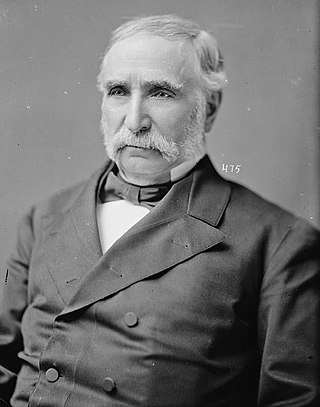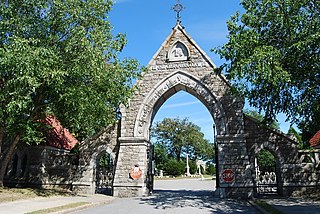
Sleepy Hollow Cemetery in Sleepy Hollow, New York, is the final resting place of numerous famous figures, including Washington Irving, whose 1820 short story "The Legend of Sleepy Hollow" is set in the adjacent burying ground at the Old Dutch Church of Sleepy Hollow. Incorporated in 1849 as Tarrytown Cemetery, the site posthumously honored Irving's request that it change its name to Sleepy Hollow Cemetery. It was listed on the National Register of Historic Places in 2009.

The Boston Brahmins or Boston elite are members of Boston's traditional upper class. They are often associated with a cultivated New England or Mid-Atlantic dialect and accent, Harvard University, Anglicanism, and traditional British American customs and clothing. Descendants of the earliest English colonists are typically considered to be the most representative of the Boston Brahmins. They are considered White Anglo-Saxon Protestants (WASPs).

Josiah Gardner Abbott was an American politician who served in the Massachusetts General Court and as a member of the United States House of Representatives from Massachusetts.

Allegheny Cemetery is one of the largest and oldest burial grounds in Pittsburgh, Pennsylvania. It is a historic rural cemetery.

Rosehill Cemetery is an American garden cemetery on the North Side of Chicago, Illinois, and at 350 acres (1.4 km2), is the largest cemetery in the City of Chicago. According to legend, the name "Rosehill" resulted from a City Clerk's error – the area was previously called "Roe's Hill", named for nearby farmer Hiram Roe. He refused to sell his land to the city until it was promised that the cemetery be named in his honor. It is located in the north east section of the Lincoln Square community area.

Mount Olivet Cemetery is a 206-acre (83 ha) cemetery located in Nashville, Tennessee. It is located approximately two miles East of downtown Nashville, and adjacent to the Catholic Calvary Cemetery. It is open to the public during daylight hours.

Forest Hills Cemetery is a historic 275-acre (111.3 ha) rural cemetery, greenspace, arboretum, and sculpture garden in the Forest Hills section of Jamaica Plain, a neighborhood in Boston, Massachusetts. The cemetery was established in 1848 as a public municipal cemetery for Roxbury, Massachusetts, but was privatized when Roxbury was annexed to Boston in 1868.

Lexington Cemetery is a private, non-profit 170-acre (69 ha) rural cemetery and arboretum located at 833 W. Main Street, Lexington, Kentucky.

Old Gray Cemetery is the second-oldest cemetery in Knoxville, Tennessee, United States. Established in 1850, the 13.47-acre (5.45 ha) cemetery contains the graves of some of Knoxville's most influential citizens, ranging from politicians and soldiers, to artists and activists. The cemetery is also noted for the Victorian era marble sculpture and elaborate carvings adorning many of the grave markers and headstones. In 1996, the cemetery was added to the National Register of Historic Places.

Chester William Chapin was an American businessman, president of the Boston and Albany Railroad from 1868 to 1878, and U.S. Congressman from Massachusetts. He was a multimillionaire at his death in 1883, and controlled one of New England’s most important rail lines.

Magnolia Cemetery is a historic city cemetery located in Mobile, Alabama. Filled with many elaborate Victorian-era monuments, it spans more than 100 acres (40 ha). It served as Mobile's primary, and almost exclusive, burial place during the 19th century. It is the final resting place for many of Mobile's 19th- and early 20th-century citizens. The cemetery is roughly bounded by Frye Street to the north, Gayle Street to the east, and Ann Street to the west. Virginia Street originally formed the southern border before the cemetery was expanded and now cuts east–west through the center of the cemetery. Magnolia contains more than 80,000 burials and remains an active, though very limited, burial site today.

Eugene Pioneer Cemetery is a pioneer cemetery in Eugene, Oregon, United States. It is one of the three oldest cemeteries in Eugene. It is the largest in both acreage and burials encompassing 16 acres (65,000 m2) with approximately 5,000 burials.

Oak Grove Cemetery is a historic cemetery located at 765 Prospect Street in Fall River, Massachusetts. It was established in 1855 and greatly improved upon in the years that followed. It features Gothic Revival elements, including an elaborate entrance arch constructed of locally quarried Fall River granite. The cemetery originally contained 47 acres, but has since been expanded to over 120 acres. The cemetery is the city's most significant, built in the planned rural-garden style of Mount Auburn Cemetery in Cambridge, Massachusetts. It was designed and laid out by local architect Josiah Brown, who is also known for his designs of early mills including the Union, Border City, and others.

Loudon Park Cemetery is a historic cemetery in Baltimore, Maryland. It was incorporated on January 27, 1853, on 100 acres (40 ha) of the site of the "Loudon" estate, previously owned by James Carey, a local merchant and politician. The entrance to the cemetery is located at 3620 Wilkens Avenue.

The Puritan is a bronze statue by sculptor Augustus St. Gaudens in Springfield, Massachusetts, United States, which became so popular it was reproduced for over 20 other cities, museums, universities, and private collectors around the world, and later became an official symbol of the city, emblazoned on its municipal flag. Originally designed to be part of Stearns Square, since 1899 the statue has stood at the corner of Chestnut and State Street next to The Quadrangle.

Chester Rural Cemetery is a historic rural cemetery founded in March 1863 in Chester, Pennsylvania. Some of the first burials were Civil War soldiers, both Union and Confederate, who died at the government hospital located at the nearby building which became the Crozer Theological Seminary.
Melzar Hunt Mosman was an American sculptor who made a number of Civil War and Spanish–American War monuments in Massachusetts.
Lake View Cemetery is a cemetery in the city of Jamestown, in Chautauqua County, New York.

























